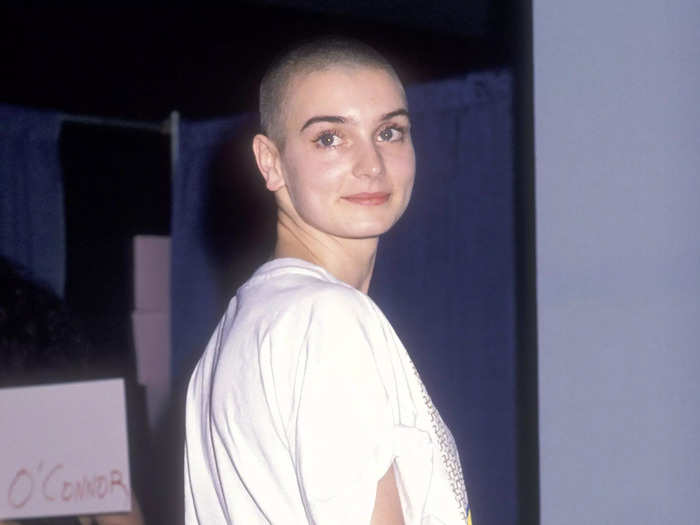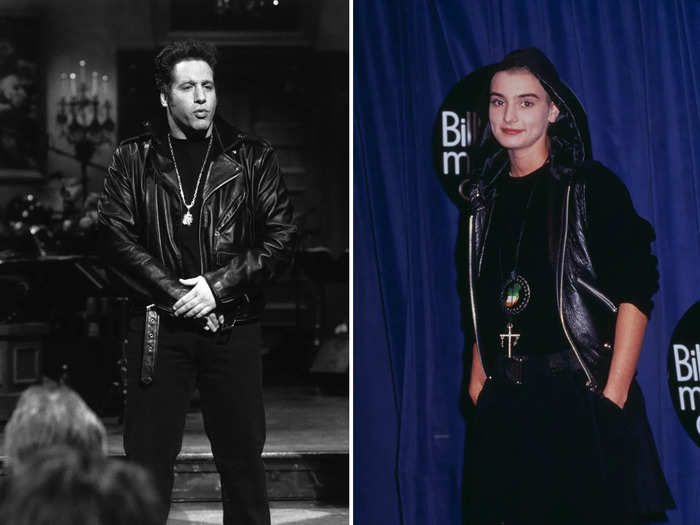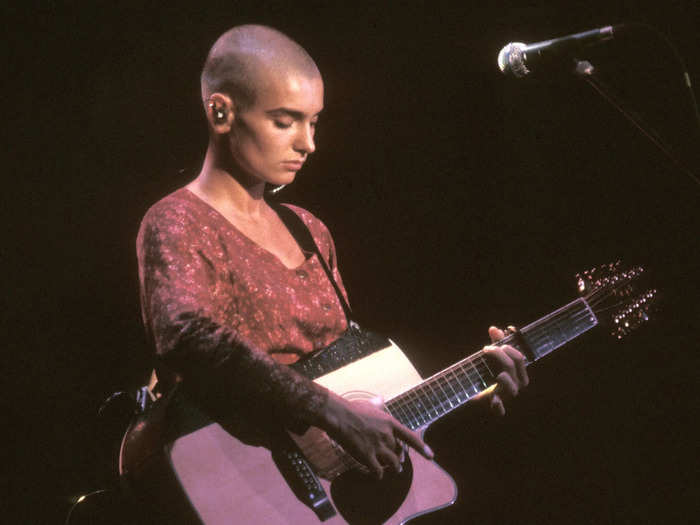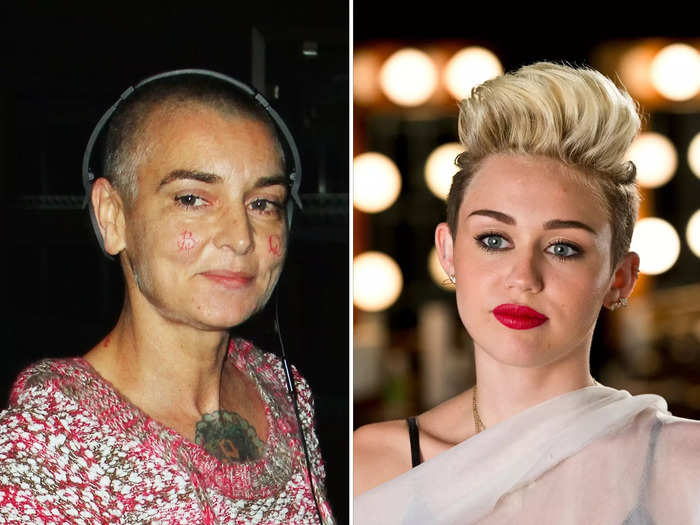Sinéad O'Connor's death at the age of 56 was confirmed on Wednesday.Yvonne Hemsey/Getty Images, Ron Galella Collection via Getty Images
- Sinéad O'Connor experienced a huge backlash after ripping up a picture of the pope on "SNL" in 1992.
- It wasn't the only time the outspoken singer used her platform to speak up for what she believed in.
Sinéad O'Connor's family confirmed on Wednesday that the Grammy Award-winning singer had died at age 56, in a statement provided to Irish news outlet RTE.
Since then, there have been outpourings of grief from the figureheads in the music industry and the media, with the likes of Russell Crowe, Cat Stevens, Conor McGregor, and Irish Prime Minister Leo Varadkar all penning tributes to the late singer.
However, as The Smiths frontman Morrissey pointed out in his own tribute posted on his website, O'Connor was met with a significant lack of support throughout her life for defying expectations of how a female pop star should behave, as she routinely used her platform to speak out about injustices.
In a defining career moment, O'Connor tore up a photo of Pope John Paul II during a performance on "Saturday Night Live" in 1992, as a means of protesting rampant sexual abuse in the Catholic Church.
The stunt sparked intense fierce criticism at the time, with Catholic celebrities, including Joe Pesci and Madonna, speaking out against her actions.
However, O'Connor later said she didn't regret doing it. Instead, she wrote in her 2021 memoir "Rememberings" that it made her feel more free.
"The media was making me out to be crazy because I wasn't acting like a pop star was supposed to act," she told the New York Times. "It seems to me that being a pop star is almost like being in a type of prison. You have to be a good girl."
Here are five other times the renowned singer stood up for what she believed in.
At the 1989 Grammy Awards, O'Connor had a rap group's logo painted on her head in protest of the Recording Academy's decision to not televise the best rap performance category.
Sinéad O'Connor at the 31st Annual Grammy Awards on February 22, 1989 at Shrine Auditorium in Los Angeles, California. Ron Galella Collection via Getty Images
Aside from an appearance on "Late Night with David Letterman" the year before, the 1989 Grammys was the first time O'Connor, then just 21 years old, found herself on a global stage, with millions of people paying attention to her.
The year also marked the first time the Grammys presented an award for best rap performance, relenting to the fact that rap music was not a fad but a musical expression that should be recognized alongside pop, rock, and country.
However, the Recording Academy's acceptance only went so far and its bosses decided to not televise the award, resulting in a boycott from rappers, including the category's inaugural winners DJ Jazzy Jeff & The Fresh Prince (aka Jeff Townes and Will Smith).
O'Connor, who was a big fan of hip-hop music and had enlisted rap artists to support her on her first US tour, decided to show her solidarity by painting the man in the crosshairs logo of the rap group Public Enemy — which frontman Chuck D said symbolizes the Black man in America — on the side of her head ahead of the performance.
By doing so, in her performance of her college radio hit "Mandinka" she forced the Grammys and its audience to confront the erasure of rap artists who had not only been left out of the awards show, but mainstream television channels and radio stations as a whole.
During the same performance, O'Connor tied her baby son's onesie around her waist to show that she was proud to be both a mother and a musician after being warned that having a baby at age 20 would ruin her career.
Sinead O'Connor wearing her son Jake's onesie around her waist at the 31st Annual Grammy Awards. Ron Galella Collection/ Getty Images
O'Connor was 20 when she welcomed her first child, a son she named Jake, with music producer John Reynolds, who she later married.
Jake was born in 1987, three weeks before the release of O'Connor's debut album. As O'Connor wrote in her 2021 memoir "Rememberings," her record label encouraged her to terminate her pregnancy as they thought being a mother would give her a negative image.
"If I was going to be a musician I ought not to have babies because a woman shouldn't leave her baby to go on tour and at the same time a child can't be taken on tour," she recalled a doctor telling her, on the instruction of Ensign Records label executive, Nigel Grainge.
"Your record company has spent £100,000 recording your album. You owe it to them not to have this baby," she alleged the doctor also said in an attempt to get her to agree to an abortion.
According to Vulture, O'Connor's decision to wear a onesie belonging to her then-16-month-old son around her waist along with her crop top, baggy, low-slung jeans, and Doc Martens at the Grammys was a "a middle finger" to those who told her motherhood would end her career.
Two years before her powerful performance on "Saturday Night Live" in 1992, O'Connor refused to appear when she was paired alongside a controversial guest host.
Sinéad O'Connor refused to appear on "SNL" alongside controversial comedian Andrew Dice Clay. Alan Singer/NBCU Photo Bank, Vinnie Zuffante/Michael Ochs Archives/Getty Images)
O'Connor withdrew from a 1990 appearance on the NBC variety sketch show after learning that the comedian Andrew Dice Clay, who was known at the time for his deliberately offensive on-stage persona known as "The Diceman," was scheduled to host.
"It would be nonsensical of 'Saturday Night Live' to expect a woman to perform songs about a woman's experience after a monologue by Andrew Dice Clay," the then-23-year-old O'Connor said in a statement at the time, per The Los Angeles Times.
She added that to perform alongside one of Clay's comedy routines, which featured jokes about sexual violence, would show "disrespect to women."
O'Connor wasn't the only one to boycott the episode. "SNL" cast member Nora Dunn also announced that she would not appear.
In 1990, O'Connor objected to the US national anthem being played at her concert in New Jersey in protest of America's "racism."
Sinead O'Connor is shown performing on stage during a live concert appearance on August 21, 1990. John Atashian/Getty Images
At a 9,000-person strong concert at the Garden State Arts Center in New Jersey, O'Connor refused to take to the stage until the organizers agreed not to play "The Star Spangled Banner" before the show.
According to The Washington Post, the venue had a policy of playing the US national anthem before every event but eventually relented fearing that a last-minute cancellation would enrage the audience. They prohibited the singer from performing there again.
When the news got out, she ended up being banned from several radio stations in New York and New Jersey.
O'Connor said at the time that national anthems "have nothing to do with music in general" but later expanded on her reasons during an acceptance speech at the Grammys that year where she picked up three major awards.
She told the audience of her reasons for not wanting "The Star Spangled Banner" played at her gigs: "It's the American system I have disrespect for, which imposes censorship on people, which as far as I'm concerned is racism."
"I didn't want to to go onstage after the national anthem of a country that's harassing people when they perform at gigs," she said.
In 2013, O'Connor advised Miley Cyrus to stop letting herself be "exploited" for her "sexual appeal" instead of developing her artistic talents.
Sinéad O'Connor penned an open letter to Miley Cyrus in 2013, warning her about being sexualized by the music industry. Phillip Massey/FilmMagic/Getty Images, Ben Cohen/Style/Getty Images
In 2013, former Disney Channel star Miley Cyrus cited O'Connor's video for "Nothing Compares 2 U" as an inspiration for her own music video, "Wrecking Ball." In response, O'Connor penned an open letter to the then-20-year-old pop star, expressing her concern about Cyrus' choice to be "naked and licking sledgehammers" in the video.
In the lengthy letter, she essentially advised Cyrus not to "prostitute" herself to the music industry.
"It is in fact the case that you will obscure your talent by allowing yourself to be pimped, whether it's the music business or yourself doing the pimping," O'Connor wrote.
Speaking from experience, O'Connor added: "The music business doesn't give a shit about you, or any of us. They will prostitute you for all you are worth, and cleverly make you think its what YOU wanted."
After O'Connor's letter, things ended up getting ugly between the two: Cyrus shared old tweets of O'Connor's asking for psychiatrist recommendations and O'Connor in turn sent two additional letters and threatened legal action.




